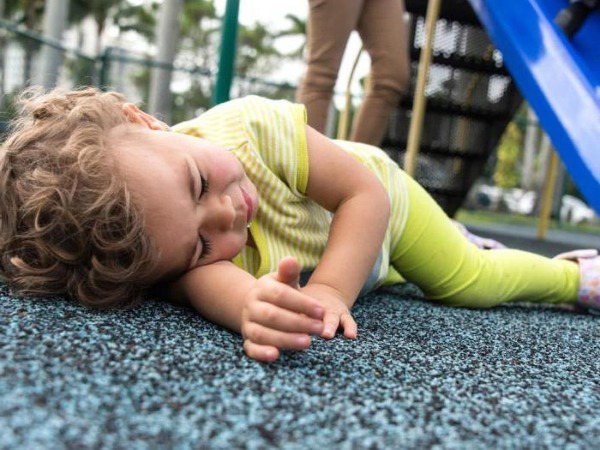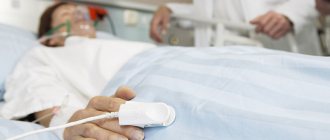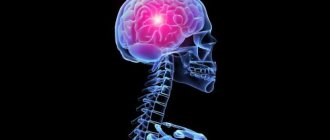Fainting in children. One of the most frightening things for parents is fainting. If a child loses consciousness, this cannot but worry, because this may indicate health problems, sometimes very serious. How to evaluate children's fainting, what can they tell their parents about, what to do, how not to panic, not to get lost, and to provide assistance to the child correctly and in a timely manner. Let's discuss this.
What is fainting? Fainting is a temporary loss of consciousness that is associated with disturbances in brain activity. The human brain performs the functions of a computer that operates in a continuous mode, constantly processing large amounts of information. Human consciousness is a kind of monitor that displays all the basic processes occurring inside our brain. If the brain-computer refuses to work, the consciousness-monitor also turns off. This is how fainting is formed, this is the body’s protective reaction to excessive effects on the brain tissue and the entire body, to such a stimulating effect that the child is unable to cope with and which can lead to irreversible changes in the brain and disruption of its functions.
What can lead to fainting. Fainting can be caused by both external causes of influences that arise in the environment surrounding the child, and internal ones that arise inside the child’s body. Let's start with external factors that can lead to the formation of fainting, the main ones include:
A sharp increase in air temperature (especially in summer or indoors). In the process of vital activity, brain tissue produces a fairly large amount of energy, which must be removed into the environment through the thin bones of the skull and dissipated. Some of the heat is carried away with the blood. If the ambient temperature rises, heat transfer may decrease, then excess energy in the form of heat can accumulate around the brain and is not expended into the environment. Then there is a lot of energy and the brain can overheat from the heat. In order not to “boil”, the brain may turn off for a while. This happens with heat stroke or sun exposure. During the brain shutdown, energy is not accumulated, but the accumulated energy is spent - the brain cools down and starts working again.
With hypoxia, that is, with a decrease in oxygen concentration in the surrounding air. The brain can work only with continuous access of oxygen to its cells, supplied through the vessels of the brain. Brain cells consume a lot of oxygen, therefore, the brain has its own blood circulation for such active nutrition. In this case, oxygen-rich blood comes from the lungs and is immediately sent to the brain so that it receives maximum oxygen. When the amount of oxygen decreases, for example. In a closed, stuffy room, the amount of oxygen progressively decreases, and brain cells begin to suffer from hunger, and the brain shuts down. A similar state can be observed when climbing mountains, where the atmosphere is rarefied.
In case of hypoxemia or increased concentration of carbon monoxide CO in the air. The process is approximately similar in principle to the previous one; hemoglobin combines with CO, and it is no longer able to carry oxygen. At the same time, brain cells also experience hypoxia and suffer, although the amount of oxygen in the air is quite sufficient for breathing. In the competition for hemoglobin, CO gas has an advantage and binds to hemoglobin more actively, so less oxygen gets to it. Carbon monoxide poisoning occurs during fires, when inhaling exhaust gases, and when staying in an enclosed space where there are sources of open fire.
Reduced intake of various nutrients by the baby. Everyone knows that the baby needs to eat properly and rationally, the diet must be balanced in vitamins, minerals and essential nutrients. It is unacceptable for children and adolescents to starve for a long time; they cannot go on diets, especially without the permission of a doctor. If children are hungry, they may faint from hunger. Brain cells actively consume not only oxygen, but also glucose, as the main nutrient for brain activity. Without glucose, the brain experiences a nutritional deficiency and cannot function, and during fasting and dieting there is usually not enough glucose. Therefore, it is important that the child has a complete and proper diet with sufficient amounts of glucose and all other necessary substances.
Emotional reactions, sometimes excessively strong positive or negative emotions, can cause a child to lose consciousness and faint. This usually happens during adolescence, and girls are more often susceptible to this. All this is associated with hormonal changes in the body - adjustments in the functioning of organs and systems. Fainting especially often can be caused by fear or pain.
Another factor for the development of fainting is severe fatigue with overload. This usually happens in the absence of daytime dreams and poor night sleep, then the brain does not have time to rest during sleep and makes forced “stops.” This is possible when moving, changing regime, or long trips.
The second group of reasons for the development of fainting are internal factors related to the child’s health. These are usually manifestations of acute or chronic diseases, metabolic disorders and other conditions affecting blood circulation and brain nutrition. These include: - decreased hemoglobin and anemia in children, in which there is less hemoglobin, which carries oxygen to the tissues, and therefore a decrease in it in the brain tissue. In this case, brain cells, when working hard, may experience hypoxia and may stop functioning normally.
Tumor processes of the brain. A tumor in the brain compresses the tissue and disrupts the passage of impulses through the brain tissue. In this case, the brain tissue experiences greater than normal loads and is overloaded. As a result, fainting occurs.
Heart disease with cerebral circulatory disorders. Such conditions include myocardial dystrophy with cardiac arrhythmias, extrasystole, causing impaired cardiac contractility and circulatory deficiency in the pulmonary and systemic circles. As a result, blood flow to the brain is impaired, resulting in disruption of brain function. Cells experience hypoxia and shut down.
The presence of autonomic dysfunction. The autonomic system is the regulator of all the main processes in the body, while the organs can work in a fairly autonomous mode so that our cerebral cortex deals with more important things. The autonomic nervous system has two divisions - parasympathetic and sympathetic. They are antagonists - one department activates, the other inhibits certain functions of internal organs. Due to the balance of their work, balance is achieved in the body. If, due to diseases or congenital or acquired characteristics of the functioning of the autonomic nervous system, the tone of any one of the systems predominates, organ dysfunction and pathological impulses to the brain can form. As a result, overexcitation of the cortex and fainting occur. During puberty, manifestations may worsen - vago-insular or symptomatic adrenal crises are formed. In this case, there is a fluctuation in blood pressure or the level of glucose and hormones in the blood, which leads to depletion of the brain in oxygen or glucose - as a result, one of the manifestations of crises is fainting.
The presence of diabetes mellitus is sometimes recognized initially by the manifestations of fainting in children. This usually occurs when there is a sharp decrease in blood glucose levels - hypoglycemia, it occurs during fasting, an overdose of insulin, during severe stress or physical activity. In this case, there is a sharp consumption of glucose, and if there is no adequate replenishment, hypoglycemia occurs. The brain experiences severe hunger and shuts down. In severe cases, fainting can develop into manifestations of coma, a deeper and more serious depression of consciousness.
Vascular spasm in the brain is usually a manifestation of autonomic dysfunction, as well as a hereditary manifestation. In this case, a sharp narrowing of blood vessels occurs in the basin of one or more cerebral arteries, not enough blood flows to the brain tissue and hypoxia occurs with loss of consciousness.
Development of osteochondrosis in the cervical spine. Yes, precisely osteochondrosis, since this disease is far from age-related and it occurs even in newborns. It is formed as a payment for intelligence and upright posture - a fairly heavy head puts pressure on the spine, under the influence of gravity, degenerative and structural changes occur in the fragile vertebrae, as a result of which osteochondrosis is formed. In this case, the cartilage between the vertebrae becomes thinner, and hernias form in the ligament area. This disrupts the normal flow of blood through the vessels passing in the paravertebral zone or passing through holes in the vertebrae, and attacks of hypoxia occur; oxygen and glucose are less well delivered to the brain. He starts to zone out.
Concussions. With strong impacts, quite strong effects occur on brain tissue and peri-cerebral fluid. In this case, the cells can shut down and fainting occurs. This occurs due to damage to certain parts of the brain.
Fainting in children - clinic and treatment:
Anna Sheveleva. a pediatrician and mother of two children, talks about, and also what to do if a teenager loses consciousness.
Fainting is a short-term loss of consciousness, which is caused by a temporary disturbance of cerebral circulation. Blood does not flow to the brain in sufficient quantities, does not bring enough oxygen, and the brain temporarily “turns off.”
Fainting often occurs in adolescents during puberty, and is especially common among girls.
Of course, loss of consciousness in a teenager cannot but cause concern for parents. Let's discuss what reasons can lead to fainting and what to do, how to help in this situation.
If a teenager loses consciousness, what to do?
If a teenager loses consciousness, you need to follow the following algorithm:
- place on a flat surface (floor, bench),
- raise your legs (you can put a bag or briefcase under them) or sit down with your head down between your knees - this will increase the flow of blood and oxygen supply to the brain.
- loosen tight clothing (it is important to provide access to fresh air - by opening doors and windows)
If the person does not regain consciousness within 1-2 minutes, place him on his side. In this case, the arm that is on the bottom (when turning to the left side - the left arm) must be extended forward so that it lies across the body, and the leg that is on top (when turning to the left side - the right leg) must be bent at the knee (see . drawing).
This position is called "stable lateral position" - the most optimal position for an unconscious person.
Call an ambulance.
Causes of loss of consciousness in adolescents
Loss of consciousness in adolescents can occur due to rather banal reasons:
- being in a stuffy room (lack of fresh air);
- severe stress (for example, possible loss of consciousness at the sight of blood);
- with a sharp transition from a lying position to a standing position (orthostatic collapse).
But quite serious vomiting can also cause fainting in teenagers.
Fainting in children - how much of an alarming signal is this? Loss of consciousness in epilepsy poses considerable danger, and extreme danger in open and closed head wounds. How to distinguish fainting from epilepsy, what are the causes of fainting and what help to provide before the emergency ambulance arrives?
Fainting occurs due to a sharp spasm of blood vessels in the brain, as a result of which the supply of blood flow and oxygen to this sector of the body slows down. A state occurs, defined by doctors as motionless, with minimal visible breathing.
The state of fainting can be temporary (brief, for 5-10 minutes).
At the same time, a coma state lasts for many hours, calculated in days. Resuscitation action is required by collapse (translation from Latin falling, fallen) - an extreme phase characterized by a drop in blood pressure and heart rate, as a result of which the blood supply (blood circulation) of vital organs deteriorates.
The etiology of syncope depends on the underlying cause:
- Edema of brain tissue. More often when introducing viral or infectious intoxication. The clinic is typical for severe forms of acute respiratory viral infections, acute respiratory infections, influenza, encephalitis, meningitis, at a temperature (over 39 degrees), heat, delirium in cold formations of double pneumonia, abdominal cavity, acute catarrh of the upper respiratory tract, tonsillitis of the larynx, scarlet fever;
- Polit cranial trauma. Squeezing, severe bruises, blows, fractures of the base of the skull;
- Displacement of the vertebral discs with pinching of nerve endings;
- (suffocation). Getting an object into the nose or throat;
- Thermal, solar overheating;
- Being in a stuffy, enclosed room without sufficient air flow, motion sickness in a car;
- Stress, shock, fear, emotional turmoil;
- Malnutrition, exhaustion;
- Dehydration due to diarrhea (watery diarrhea).
The origins are numerous, and the consequences equally insidious. Frequent fainting does not go unnoticed for a child. A tomography examination reveals adhesions of spasmodic contractions, microcracks, and ruptures of blood vessels on the walls of brain vessels, as after epileptic seizures. In the future, this algorithm will result in headaches, attacks of nausea, dizziness, and memory impairment.
Causes of fainting in adolescence, current issues of diagnosis and treatment
Fainting (syncope) is an attack in which loss of consciousness occurs. Syncope is accompanied by a drop in blood pressure, muscle tone, weak pulse, and shallow breathing. The prevalence of syncope in children under 18 years of age is 15%. The majority of all syncope in adolescents are neurogenic syncope (24-66%), orthostatic (8-10%), cardiogenic (11-14%). A teenager faints due to exposure to stressful situations, a drop in blood pressure, or the presence of heart disease.
There can be many reasons for fainting
Teenagers faint, why? Fainting conditions have various causes. Depending on this, there are several types of syncope.
- vasovagal (in stressful situations, medical procedures, fainting when changing body position);
- situational (provoked by sneezing, cough reflex, playing musical instruments, eating, laughter);
- irritation of the carotid sinus;
- Ideopathic.
Orthostatic (for hypotension):
- primary autonomic failure (autonomic dysfunction (VSD), multiple system atrophy, parkinsonism with autonomic dysfunction, Lewy dementia praecox);
- secondary autonomic failure (diabetes mellitus, amyloidosis, spinal cord injuries);
- toxic hypotension (alcohol-containing substances, diuretics, vasodilators, antidepressants);
- decreased blood volume (dehydration, blood loss).
- arrhythmogenic (bradycardia, tachycardia, drug arrhythmias);
- structural (valvular heart defects, pulmonary embolism, aortic aneurysm, hypertension in the lungs).
Vasodepressor syncope may occur in young people in stressful situations.
Why did the teenager faint, reasons? The most common cause of fainting in adolescents is considered to be neurogenic. In patients, fainting occurs due to severe stress, fear, reflex sneezing, coughing, and irritation of the carotid sinus. The most pronounced etiology is stress, since the nervous system in adolescents is not yet formed.
There is evidence that a child’s brain becomes most active during puberty. This is due to hormonal changes. During puberty, a child may be very excited, irritable, fears, worries, and depression may appear. A depressive state always leads to autonomic dysfunction in adolescents, which helps reduce blood pressure and constrict blood vessels in the brain. A lack of blood flow leads to a fainting attack.
Heart disease may be a common cause of fainting in teenagers. They occupy a considerable percentage of all syncope states. Syncope occurs due to arrhythmias, as well as organic pathologies of the heart (vessels, valves). With bradyarrhythmia, the heartbeat is too slow. This leads to a slowdown in blood flow and brain hypoxia.
Tachyarrhythmia is a rapid heartbeat, more than 140 beats per minute. At the same time, the heart muscle begins to consume more blood. Over time, the myocardium begins to receive less nutrition, and the ventricles do not absorb blood well. The amount of blood pushed out by the ventricles of the heart decreases, which leads to brain hypoxia.
Another cause of fainting in a teenager may be pathologies of the heart valve apparatus. If the atrioventricular valves do not function properly, blood flow to the ventricles will be maintained, but blood ejection will be reduced. The amount of blood pushed out becomes less because when the ventricles contract, the valve does not completely cover the opening to the atrium.
During ventricular ejection, part of the blood flows back into the atrium. Insufficiency of the atrio-aortic, as well as the pulmonary valve, contributes to a decrease in the overall output of blood and a deficiency of oxygen in tissues (pulmonary, cerebral). Diseases of the valve apparatus can occur in both boys and girls.
Why does a teenager faint, reasons? Syncope in adolescents often develops due to improper medication use. Many drugs in adolescence can reduce blood pressure, cause tachycardia or bradycardia, and severe cerebral vasospasm. Usually, when these drugs are discontinued, fainting stops on its own.
Orthostatic fainting can occur due to improper functioning of the autonomic system. The patient's blood pressure drops sharply, especially when changing position (rising from a lying position, from a squatting position). At the same time, less blood enters the brain, after which the patient loses consciousness. Syncope in girls occurs with heavy periods. The patient may faint with increased physical activity during menstruation, as blood loss increases and blood pressure decreases.
Almost all fainting attacks have the same symptoms. There are several stages of fainting.
- presyncope;
- the fainting attack itself;
- postsyncopal.
The pre-syncope period can be manifested by headache, tinnitus, stupor, nausea, dizziness, darkening of the eyes, abdominal discomfort, increased sweating, drop in blood pressure, and a slight decrease in temperature. The duration of this period ranges from several seconds to several minutes. At the end of the first period, the patient falls.
Fainting is preceded by a presyncope period
Fainting itself is manifested by loss of consciousness, slow heartbeat, thread-like pulse, and low blood pressure. The duration of a fainting attack is 30 seconds. A cardiogenic attack lasts from 1.5 to 5 minutes. Cardiac syncope may be accompanied by edema, clonic convulsions, and bluish skin.
The post-syncope period is characterized by restoration of consciousness, possible weakness, vestibular disorders, fear, thirst. If you rise suddenly to a standing position, a second attack of syncope may occur.
Patients with heart disease have a high risk of mortality due to sudden cardiac arrest.
Features of clinical manifestations of cardiac syncope:
- The onset of the attack does not seem to be vasovagal (stress).
- The patient may lose consciousness even at rest.
- Syncope lasts 1.5-5 minutes.
- The attack is preceded by: shortness of breath, cardialgia, palpitations.
- Fainting appears during, after physical activity, swimming.
- Clonic convulsions are possible.
- The presence of pathological neurological symptoms after an attack.
- In severe cases, syncope requires resuscitation measures.
- During an attack, the child is pale, after which there is skin hyperemia.
- Blueness in the chest, auricle, mucous membranes, nose.
After collecting anamnesis, the patient is prescribed additional examination methods.
Diagnostic measures include the collection of anamnestic data, patient complaints, examination, and additional research techniques. During an attack, the doctor assesses the presence of breathing, heartbeat, skin color, heart rate, and conducts auscultation (listening) of the lungs and heart. To clarify the causes of fainting, the patient is examined. The patient is prescribed a clinical blood test, urine test, and biochemical analysis (creatinine, urea, liver tests).
Additional examination methods:
- magnetic resonance imaging (MRI) of the brain (detects volumetric, structural pathologies of the brain);
- computed tomography (CT);
- Doppler ultrasound of the vessels of the neck and head (USDG) (examines the speed of blood flow in the brain);
- electroencephalography (EEG) (measures the electrical activity of the brain);
- electrocardiography (ECG) (shows the nature of the heart rhythm);
- EchoCG (ultrasound examination of the heart) (diagnoses organic heart disease);
- Holter ECG monitoring (assesses the rhythm pattern over a period of 24 hours or more).
Symptoms
Children with repeated attacks of fainting have difficulty learning, do not remember well, their auditory and visual functions are impaired, and they lag behind the physical and mental development of their peers. What manifestations should alert adults and show that a child is on the verge of losing consciousness?
The first thing people notice is the pale face. Blueness (cyanosis) appears near the nasal and lip areas, the fingernails are purple in color, the hands and feet are cold. There is sweaty perspiration on the forehead, the gaze is dull, meaningless.
The following signs: unsteadiness of gait, “falling to one side,” “sliding” to the floor, the ground, the child becomes limp. The pupils are dilated and do not shrink to light; sometimes the whites of the eyes “roll” under the upper eyelid. The child does not respond to sounds or touches.
- Interesting read:
It happens that children have time to complain that they are “nauseous” and have a ringing noise in their ears. There is urinary incontinence and vomiting. This indicates that symptoms of developing syncope have appeared.
Differences from epilepsy
It should be noted that against the background of the mentioned slow fainting states, neuropathology described sheaf-shaped seizures that suddenly crippled the child. Seizures with convulsions, foam at the mouth, involuntary urination: these indicate the presence of epilepsy.
This is a chronic disease, a nervous pathology, manifested by repeated convulsive twitches, inarticulate screams, and loss of consciousness. Examinations confirm: the consequences of epilepsy are expressed in personality changes and mental destruction.
In ancient times, the disease was called “black epilepsy”; the exact origins are not fully understood. These are both acquired factors (with forceps during childbirth, post-traumatic syndrome), and congenital, hereditary, passed down from generation to generation. It is not difficult to distinguish a true epileptic picture: in ordinary cases, the child rarely screams, there is no foamy discharge from the mouth, no urinary or fecal incontinence.
Muscle tension in the form of stupor, arching of the back, noisy, hoarse and intermittent breathing, collapse - such signs are characteristic of, but absent in fainting.
Classification
- Vasovagal. Fainting resulting from strong emotional experiences. Most often they occur in children with psycho-emotional instability or vegetative-vascular dystonia. This condition typically occurs when seeing blood, visiting a dentist, being in a hot room, or in anticipation of pain.
- Orthostatic. They develop if you rise suddenly or stay in a standing or lying position for a long time, with heavy bleeding, while taking sedatives or diuretics.
- Hyperventilation. Occurs during severe hysteria; rapid breathing contributes to its development.
- Situational. Fainting can occur when urinating, defecating, coughing, or swallowing. So a provocateur can be coughing during whooping cough or swallowing with a full stomach.
- Sinocarotid. Occur due to irritation of the carotid sinus, which occurs after injury to the neck, with compression by lymph nodes, an abscess, hemorrhages, infiltration or other formations.
First aid
If a child faints, you should never panic, fall into despair, or become hysterical! Clear actions of adults: a lot depends. Pre-hospital emergency care does not contain any risk. Your task is to keep the child in a safe position until the medical team arrives. Take the time to undergo the appropriate examination, and strictly follow the instructions of your doctor.
The emergency aid algorithm should be as follows:
- Immediately move the child to a cool place, provide access to oxygen, free the chest from constricting clothing;
- Raise your body, place it in a reclining position so that your chin rests on your chest;
- Wet a cotton swab with ammonia and pass it under your nose (without touching the skin);
- Add 3-4 tablespoons of vinegar to cold water and dip the edge of the handkerchief. Wipe your forehead and neck. Behind the ears, elbows, palms, feet.
It is strictly forbidden to shake, shake, or turn over on the stomach. Lightly patting the cheeks to try to bring him to his senses, but do not overdo it. It is better to fan with a damp towel, achieving air flow. Tablets, powders, and medications are contraindicated at this stage, as well as attempts to give water to drink.
This cannot be done. And it should not be because the little person is temporarily deprived of swallowing movements; forcible pouring is fraught with liquid entering the respiratory organs.
Prevention
The surest way to protect a child: grief, misfortune, such as collapse, is to apply and not part with the wise postulates of health: prevention, preventing preconditions, eliminating the cause of childhood fainting. Establish a permanent friendship with a physical person. exercise, sports. Instill in your offspring a love for a healthy lifestyle. Are you cheerful yourself? And your sons and daughters take your example.
The causes of diseases lie in a frail body, an irritable and neurasthenic posture towards people, and a disdainful attitude towards the animal and plant world.
Help from neuropathology is necessary, but without the personal participation of each family member it is impossible to cope with serious illnesses. Especially for those members of society who are just growing. They need the merciful help of Good. Calm, affectionate word from mom and dad. Heartfelt conversation between grandparents. Strong support from sisters and brothers. In kindergarten, school, in the yard and on the tram.
Collapse affects the body. But be warned! It freezes the soul too. Cruelty in relationships, scandals, quarrels in the family circle affect the psyche of children. They are suffering. Therefore, childish fainting statistics are 100% colored by the obviousness of such adult causes.
Not only an adult, but also a child of any age can lose consciousness, however, most often this happens to adolescents during puberty. Any adult should know and understand how to identify the causes of fainting and how to provide first aid in case of loss of consciousness.
Causes of loss of consciousness in a child
The root causes that cause fainting in a child are divided into external and internal.
External factors:
- disturbance of heat exchange (when the air temperature rises, the body’s heat exchange with the external environment is disrupted, the brain overheats and “turns off.” When the balance of heat regulation between the body and the external environment is restored, the child comes to his senses);
- decrease in the level of oxygen in the air (the brain reacts very quickly to a lack of oxygen. When nerve cells sense a decrease in oxygen levels, they stop performing their functional duties because of this);
- increased amount of carbon oxides in the air (the mechanism is similar to the previous one: nerve cells, due to “starvation,” stop functioning, despite the fact that they receive a sufficient amount of oxygen. This condition is similar to climbing a high mountain);
- unbalanced diet (as a result of an inadequate breakfast, long intervals between meals or small amounts of food throughout the day, a small amount of glucose enters the blood, the sugar level “falls” and the brain stops working properly);
- improper daily routine (lack of sleep at night and physical and/or mental overload during the day causes a lack of rest for the brain, so some cell structures begin to work incorrectly);
- the child cried a lot (the baby threw a tantrum, during which he may lose consciousness due to the nervous system not being fully formed);
- severe fear, stress (for example, before a vaccination or some other injection. The brain turns on a defense mechanism);
- side effects from medications that lower blood pressure (with improper use of medications that can cause a drop in blood pressure, most often in the case of an overdose).
Internal reasons
- anemia (decrease in the level of hemoglobin in the blood. Lack of oxygen can cause a malfunction of the nerve cells of the brain);
- brain tumors (tumors that grow in the brain, over time, interfere with the transmission of signals to organs and they return back to the brain, overloading it with additional work);
- disturbances in the functioning of the cardiovascular system (if blood is poorly pumped by the heart, then oxygen starvation of the brain occurs. This is the most dangerous cause of fainting, since cardiac arrest occurs, and loss of consciousness is characterized by suddenness, without warning.);
- hormonal changes (hormonal levels are disrupted, which provokes emotional outbursts, especially in girls, and due to changes in the body, the brain “turns off”);
- disorder of the autonomic nervous system (occurs most often during adolescence);
- excessive use of insulin (causes a sudden drop in blood glucose levels, starvation of brain cells, which is one of the factors in the occurrence of sudden fainting leading to a state of coma);
- osteochondrosis of the cervical spine (under the force of gravity, the vessels that pass through the spinal column suffer, which impedes blood circulation and a deficiency of oxygen and energy occurs in the brain);
- concussion (brain functions are disrupted, as a result of which some parts of the brain stop working);
- severe cough (caused by severe irritation of the larynx or trachea, as a result, little oxygen enters the lungs, oxygen starvation of the brain begins and loss of consciousness occurs);
- excessive laughter (changes in the body similar to coughing occur).
Internal factors that can trigger syncope
If a child’s fainting and nausea are short-term, this is a reason to think about changing the daily routine. Systematic loss of consciousness is a pathological condition that cannot be ignored.
Fainting, ailments in adolescents and their causes may be associated with the following diseases:
- Brain diseases. Cystic formations, tumors, and injuries to the vascular network reduce the efficiency of the “gray matter” functioning, causing fainting. If a child complains of darkening of the eyes, headaches, or hallucinations, it is necessary to urgently consult a doctor and undergo a CT and MRI.
- Anemia. Pathology of the circulatory system associated with the functioning of the organ: low levels of red blood cells - oxygen carriers, cause starvation, which leads to constant fainting. Low hemoglobin is the first sign of the onset of the disease. It is necessary to review the child’s diet, supplement it with fruits, vegetables, and nutrients.
- Impaired performance of the heart muscle, arrhythmia. According to statistics, 30% of crises are associated with heart pathologies; in addition, the “quick death” syndrome is preceded by constant fainting. If the baby’s parents suffer from similar diseases, this is the first warning call - the child needs to be shown to the doctor urgently.
- High pressure. Hypertension can overtake a patient, even at a young age. A sudden drop in blood pressure can also cause syncope.
- Diabetes. This disease is quite insidious: it can occur in a latent form for a long time. The pathology itself does not cause fainting, but it can be triggered by low glucose levels. Due to starvation of the “gray matter” cells, the baby loses consciousness.
- Concussions, TBI. Children are hyperactive; they lose their balance and fall, which is normal for them. After a short cry, they can continue to go about their business, but sometimes the consequences of a fall can remind themselves for a long time.
- Osteochondrosis. Ideal posture is the key to a healthy back and proper functioning of internal systems, but this is difficult to prove to children. A crooked posture at the table and excess body weight lead to changes in the spinal column. Blood flow is disrupted, starvation occurs, and painful discomfort appears. All these factors are the main causes of syncope.
Parents of the baby should monitor his behavior and development: complaints even about small details can hide the development of threatening symptoms. Children who often fall are not immune to injury, which can only worsen their condition. An adequate approach to treatment will help prevent further development of the syndrome, sometimes saving the child’s life.
Symptoms of loss of consciousness in a child
The three most reliable signs of fainting are:
- pale skin;
- cold sweat;
- in rare cases, the first two symptoms are supplemented by involuntary urination and short-term convulsions.
Symptoms that the child begins to feel before loss of consciousness (precursor period):
- general weakness;
- palpable tachycardia;
- nausea;
- dizziness;
- “darkening” in the eyes;
- loss of balance;
- noise in ears;
- discomfort in the stomach or throughout the abdomen, such as cramps;
- rolling of the eyes and dilation of the pupils.
Diagnosis of fainting conditions
To begin with, the child must be examined by a pediatrician and a neurologist. Then, consultation with specialized specialists such as a cardiologist, endocrinologist, psychiatrist, etc. may be required.
Laboratory research methods can help diagnose the main cause of fainting:
- general blood analysis;
- general urine analysis;
- blood gas composition;
- determination of blood glucose levels;
- glucose tolerance test;
- blood chemistry.
And also the following examinations:
- electrocardiogram (ECG);
- electroencephalogram (EEG);
- rheoencephalogram (REG);
- echoencephalogram (Echo-Eg);
- Ultrasound diagnostics of external cranial vessels (USDG).
If malfunctions in the cardiovascular system are suspected, doctors may prescribe:
- ultrasound examination of the heart (ultrasound);
- phonocardiography;
- daily ECG monitoring;
- load tests.
If brain damage is suspected, the following examinations are prescribed:
- multislice computed tomography (MSCT);
- magnetic resonance imaging of the brain (MRI);
- magnetic resonance angiography (MRA);
- duplex scanning;
- radiography of the spinal column.
For fainting of unknown origin, a passive orthostatic test (Tilt-test) is prescribed, which reveals the connection between the fainting state with the work of the heart and changes in blood pressure.
Factors influencing the development of the disease
1. Hyperthermia
Quite often, the cause of seizures, which are accompanied by loss of consciousness, is high body temperature. Most often, hyperthermia with convulsions occurs in childhood. For adult patients, the temperature limit is 40 degrees. In children, convulsions can occur at a temperature of 38-39 degrees.
2. Pregnancy
Loss of consciousness, accompanied by convulsions in pregnant women, is considered one of the most dangerous complications, the result of which can be premature birth, disturbances in intrauterine development of the fetus, etc. This condition reminds us of coma and with frequent fainting, there is a possibility of death for the woman.
This condition does not appear very often, but is considered a rather serious problem in medicine. This situation is accompanied by sudden pallor of the patient, he loses consciousness with the onset of a convulsive attack. Loss of consciousness can be sudden, and after the attacks the patient can sleep soundly for 6-7 hours.
Sudden fainting in children, accompanied by convulsions, requires mandatory medical intervention, since the consequences of such symptoms can be unpredictable. Often the cause of this condition is traumatic brain injury. Brief loss of consciousness is complicated by sudden bleeding from the ears and mouth. In this case, emergency hospitalization of the child is necessary to clarify the diagnosis and further treatment.
In children under 2 years of age, convulsive fainting is possible with increased excitability of the nervous system. In this case, an external stimulus can be a loud cry, which is accompanied by cessation of breathing during inspiration, cyanosis of the nasolabial triangle and hypoxia, which ultimately leads to loss of consciousness. However, it is important to consider that in some cases the opposite effect is possible when fainting is preceded by a seizure, which is most often provoked by hyperthermia. In addition, children have a hereditary predisposition to developing seizures, which can occur with normal fainting.
Fainting is a temporary loss of consciousness that is associated with impaired brain function. There are many reasons for this illness. Both natural overstrain and serious pathological processes can provoke a short-term “shutdown” of the main node of the body.
Regardless of the factor that provoked fainting, it is unacceptable to ignore it. Even a one-time loss of consciousness is a good reason for a thorough examination of the body.
There are many reasons and factors that can cause a teenager to faint
As noted earlier, fainting is a phenomenon associated with a short-term loss of consciousness in a person. Almost always, its development occurs due to disturbances in cerebral circulation, and only occasionally does “switching off” the brain occur at the neural level in the absence of problems with oxygen supply.
If we consider fainting as simply as possible, we should highlight the following structure of its occurrence:
- Lack of oxygen in the brain (less often other problems).
- Disabling the functioning of an organ for protective purposes and, as a consequence, loss of consciousness by a person.
- Normalization of brain function and the condition of the victim.
Fainting in adolescents is not considered rare or unusual. During puberty, changes in the body are inevitable, so people with particularly sensitive bodies may experience periodic loss of consciousness.
In any case, fainting in a teenager is a phenomenon that requires attention, so ignoring it or treating it as some kind of norm is wrong and even dangerous.
There are many factors that can provoke loss of consciousness in a person. Conventionally, they are divided into two groups: pathological and non-pathological. The first reasons include:
- elevated ambient temperature
- lack or severe contamination of inhaled air
- poor nutrition
- severe psycho-emotional shock
- fatigue or severe physical overload
- hormonal imbalance (especially important for the group of people being considered today – teenagers)
Pathological causes of fainting include:
- course of any types of anemia (lack of hemoglobin in the body)
- tumors and other brain lesions
- pathologies of the cardiovascular system
- autonomic dysfunctions
- diabetes
- short-term or chronic spasm of vascular structures
- neck osteochondrosis
- strong blows to the skull, provoking the development of a concussion
Any provoking factor requires due attention and elimination on the part of the teenager’s parents. It is undesirable to ignore either one-time or systematic manifestations of fainting. Loss of consciousness simply cannot be considered normal, which should not be forgotten.
First aid for fainting
To provide first aid to a child in case of loss of consciousness, it is extremely important to follow a clear algorithm of actions.
- If possible, catch your child before he falls to avoid injury from a fall.
- Place him in a horizontal position (constantly make sure that the tongue does not sink in and block the airway);
- Tilt your head back a little (you can put something rolled up from clothing under your neck).
- Raise your legs 30 - 60 degrees.
- Unfasten clothing (loosen tie, unfasten buttons or zipper) or remove it if clothing is tight and cannot be unbuttoned.
- Create a flow of air (open a window, door, turn on a fan, fan). If a child loses consciousness in a stuffy room, then you need to immediately take him out into the air.
If you have time to provide first aid in case of fainting, you can avoid many negative consequences, and even save the child’s life.
Usually, after fainting, the child quickly regains consciousness before the ambulance arrives.
But you need to know if:
- 3 minutes passed and the child did not come to his senses;
- an excess of saliva is noticed, retching and vomiting are clearly visible;
- it is clear that breathing is difficult.
It is necessary to place the child in a “sideways” position, if possible, place a towel under the chin and chest, and call an ambulance.
If a child who has lost consciousness quickly regains consciousness and seems healthy, consultation with a specialist is still necessary. The child should be closely monitored before consulting a doctor.
During loss of consciousness you do not need to do:
- speak very loudly;
- hit on the cheeks;
- use ammonia (aka ammonia) - against an unpleasant odor, the child can sharply throw his head back and damage the neck or back of the head;
- shake the child;
- pour water over your face (wiping with a damp cloth is enough).
When the child regains consciousness, a recovery period begins, which can last from several minutes to 1-2 hours. During the entire period, the victim should be in a horizontal position, without getting up or sitting down. When the child begins to feel normal, you need to give him warm, sweet tea.
The consequences of loss of consciousness are not long-lasting; they are manifested by pale skin, increased sweating, and general lethargy.
It is imperative to monitor the child’s breathing and pulse before the ambulance arrives if he does not come to his senses for a long time. In case of stopping breathing and heartbeat, you must immediately begin resuscitation actions: chest compressions and artificial respiration mouth to mouth, mouth to nose (if there is a foreign body in the oral cavity), mouth and nose (if the baby’s age does not allow you to cover his lips with your lips ).
Massaging the child's heart is done with the fingers at partial strength, so as not to injure the chest. For a child under 1 year of age, indirect cardiac massage is performed with the index and middle fingers or thumbs with the palms wrapped around the chest.
Resuscitation is carried out in a ratio of 30:2 (2 breaths: 30 presses on the heart area), if the parent is alone and 1:5 (1 breath: 5 presses on the heart area), if someone can help the parent.
What should you do if your child has lost consciousness and is foaming at the mouth?
As a rule, this is how an epileptic seizure manifests itself. The eyes roll back, the muscles contract in convulsions during an attack, and the jaws are tightly clenched. What first aid can be provided in this situation:
- if there is someone nearby, ask him to call an ambulance;
- do not try to hold the child during a seizure;
- do not try to unclench your jaws;
- remove anything that could injure a child;
- try to put something under your head to soften the blows.
- wait for the ambulance to arrive, which will provide emergency care to the child.
Symptoms of the pathological condition and the mechanism of its development
If a child suddenly faints, the cause of the crisis is a disruption in the functioning of the “gray matter” due to a sharp outflow of blood.
For some time, the little patient loses sensitivity and cannot control his movements. Alarming symptoms before the onset of a crisis in a teenager may include:
- a sudden surge of weakness - the child sag, the epidermis turns pale;
- mild attack of vertigo, darkening of the eyes;
- nausea, severe tinnitus;
- unstable pulse;
- increased sweating.
The baby suddenly sinks to the ground and does not react to what is happening around him for half a minute. After the fallen person has regained consciousness, he does not realize for some time what happened to him, being in prostration.
The cause of loss of consciousness is disturbances in brain function
Let us further consider such a problem as fainting. We will discuss the reasons for this condition a little later. First, I would also like to say that there are several types of this problem:
- Swoon. In medicine, it is called the mildest form of fainting. It lasts no more than a couple of seconds. If the patient is given timely assistance (and also provided with a sufficient amount of oxygen), fainting may not occur. Symptoms such as ringing in the ears, yawning, slight dizziness and brain fog will be seen.
- Simple fainting. In this case, the person completely loses consciousness for about 5 seconds. In this case, muscle tone most often turns off, and the person slowly sag. You should not touch a fainting victim (tugging, hitting the cheeks). It is best to simply lay it in a horizontal position (this will provide oxygen access to the brain, which will lead to normal blood circulation).
- Fainting convulsive. In this case, convulsions are also added to the loss of consciousness. However, doctors say that if a person is unconscious for about 20-30 seconds, he cannot avoid seizures in any case. It is very important to ensure minimal trauma to the person, because during this condition the head, arms, and legs can be damaged. It should also be said that convulsions occur as a result of hysterical or epileptic seizures.
- Bettolepsy. In this case, fainting causes disruption of normal lung function. It occurs as a result of a very prolonged cough. Indeed, in this case, the normal outflow of venous blood from the head becomes impossible. The duration of fainting is short. In this case, it is almost impossible to help the patient. The reason needs to be investigated. So, most often the fault is the improper functioning of the blood vessels.
- Drop attack. To be precise, it doesn’t even look like a classic fainting spell. After all, in this case, loss of consciousness does not occur. The man just falls. This occurs mainly in the case of certain diseases. Also, similar conditions are often observed in pregnant women.
- Vasodepressor syncope. It is typical mainly for children. It occurs as a result of overwork, lack of sleep or prolonged exposure to a stuffy room. In this case, it is better if the child undergoes additional examinations. After all, it is necessary to exclude a variety of diseases of the nervous system.
- Orthostatic fainting. Occurs when a person abruptly changes the position of his body, i.e. from a lying state goes into a standing or sitting state. In this case, the circulatory system does not have time to switch. Often, a similar condition can occur if the patient takes certain medications: beta blockers, nitrates, diuretics, etc. It should also be noted that in this case there may not be a complete loss of consciousness; often only dizziness and slight clouding of consciousness are observed.
- Arrhythmic syncope. In this case, fainting is caused by various types of arrhythmias.
- Fainting can also occur in the case of a hypersensitive carotid sinus. In this case, this condition can be caused, for example, by tightly tightened collars or ties.
Memo to parents
First of all, parents should teach their child that at the first sign of fainting, he should immediately sit down or lie down, so as not to fall and not get hurt during a fall.
Teach your child and ensure that some rules are followed:
- do not get out of bed abruptly, especially after sleep;
- do not stand for a long time;
- eat well on time (especially breakfast);
- do not exhaust yourself with diets - this applies to adolescents in adolescence.
The most important thing is to visit specialists to find out the reason that provoked the loss of consciousness and strictly follow all recommendations.
If a child often faints, then you need to ensure his safety, not let him go out alone, know the basics of first aid and be able to apply them in practice. You should try to protect your child from stressful situations.
It is important to engage in procedures that strengthen the body. Hardening, light sports. Of course, this should be done under the strict supervision of a parent. Do exercises with your child, walk in public gardens and parks in the mornings and evenings. Drink vitamins. Normalize your sleep and daytime routine.
Fainting is a brief loss of consciousness. Losing consciousness in a teenager is a fairly common phenomenon, often not at all dangerous, but if your child faints, it is still advisable to consult a doctor, since the causes of loss of consciousness in adolescents vary - from minor to very dangerous.
Causes of fainting in teenagers
Most often, vasovagal fainting occurs in adolescents, which occurs from overwork, fatigue, lack of sleep, pain, emotional overstrain, and also in stuffy rooms. Before such a faint, sometimes within a few minutes, and sometimes within a few seconds, the head begins to feel dizzy, nausea and blurred vision appear. If you have time to lie down at this moment, that is, take a horizontal position, then you may be able to avoid fainting.
This type of fainting belongs to a group of fainting spells that are not associated with any cardiovascular disease. This group also includes the following types:
But there are more dangerous reasons for a child fainting - they are associated with diseases of the cardiovascular system. Before such a faint, the child feels some “interruptions” in the beating of the heart, his face becomes very pale or even blue during the attack, and the pulse during the faint is either very rare or completely absent. Such fainting is dangerous as it carries a risk of sudden death.
If your child has lost consciousness, you should definitely consult a doctor to be sure that the causes of fainting are not dangerous. You will need to go not only to a neurologist, but also to a cardiologist. If you find out the reasons for fainting in time, this will protect you from unnecessary worries and will be able to help your child in time.
Causes
There are a large number of different factors that, one way or another, cause fainting in children and adolescents.
Anemia
Anemia is one of the main causes of loss of consciousness in childhood. This disease most often occurs in late winter or early spring. By this time, the body loses all its vitamins and microelements. If they are insufficiently replenished, the iron content in red blood cells - erythrocytes - decreases.

If your baby does not eat for a long time, then this is the direct cause of fainting. The baby's brain is very sensitive to a lack of glucose. Be sure to take yoghurts, cookies and juice with you if you are going away for a long time.
In addition, frequent and sharp drops in blood sugar levels, which are accompanied by fainting and pre-fainting conditions, may be the first symptom of diabetes. Therefore, do not delay your visit to the pediatrician!
With prolonged hysteria or screaming of the baby, excessive ventilation of the lungs and overexcitation of the nervous system occurs. Therefore, it is better not to bring the baby to this state.
If the vaccination is given to a very impressionable child, then the result of such a procedure may be fear. And this is the direct reason why the baby faints. Be sure to talk to your doctor before the procedure about your child's tendency to lose consciousness in stressful situations. It may be worth asking a child psychologist about methods for overcoming these fears.
A comprehensive examination must be completed in the first year of life. Fainting may be the first sign of a vascular or cardiac pathologist. If the circulatory system and heart are not functioning well (for example, arrhythmia), the brain does not receive the required dose of nutrients and oxygen.
Before falling, the child may feel that the heart is “pounding”, beating as if incorrectly. In such a situation, you should immediately seek help from a specialist.
In teenagers, fainting most often occurs as a result of overwork associated with studying, as well as emotional distress, and lack of sleep. Girls may not feel well when on half-starvation diets. Parents also need to monitor and, if necessary, limit the time a teenager spends on the computer. The immature nervous system of a young person is very sensitive to negative influences.









